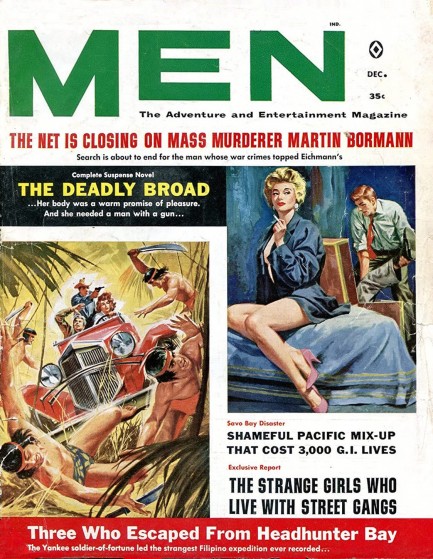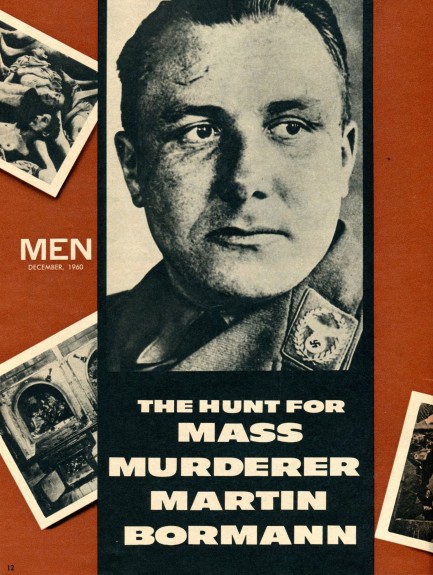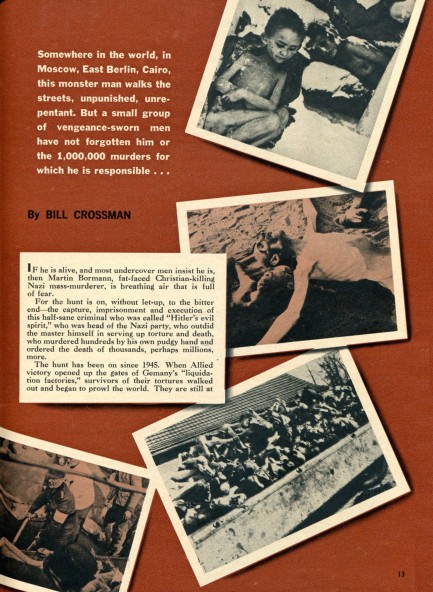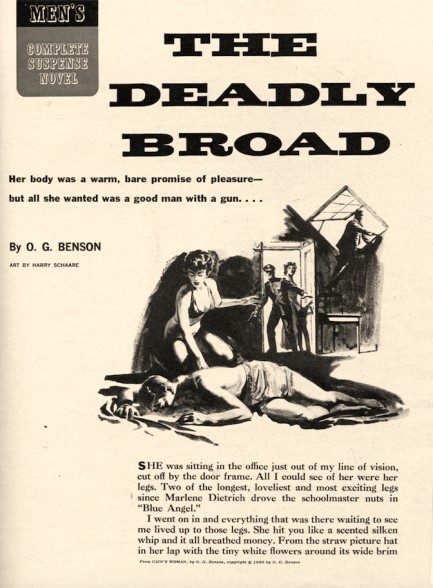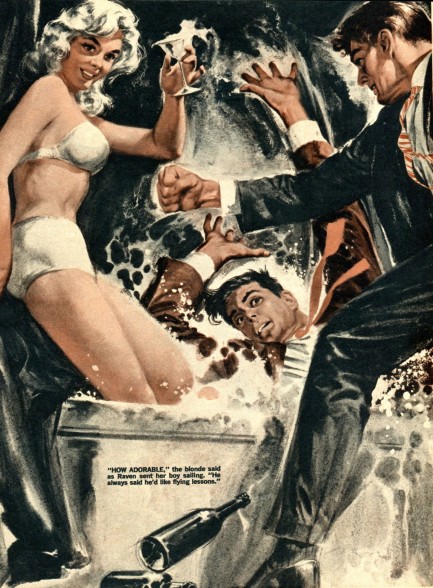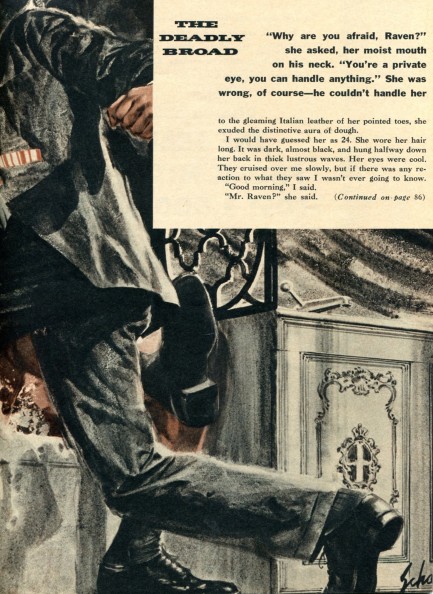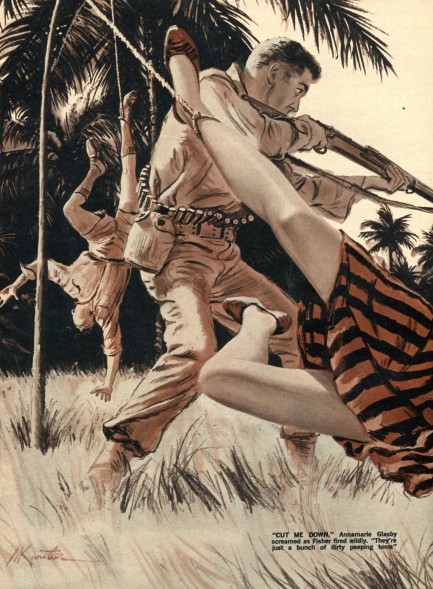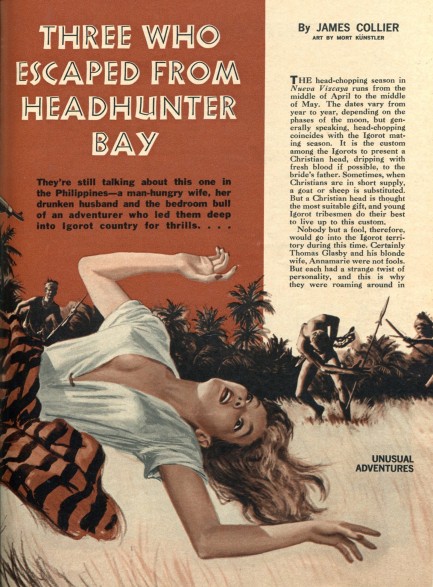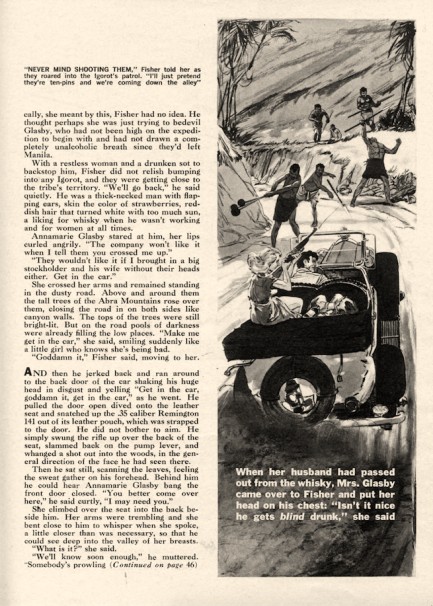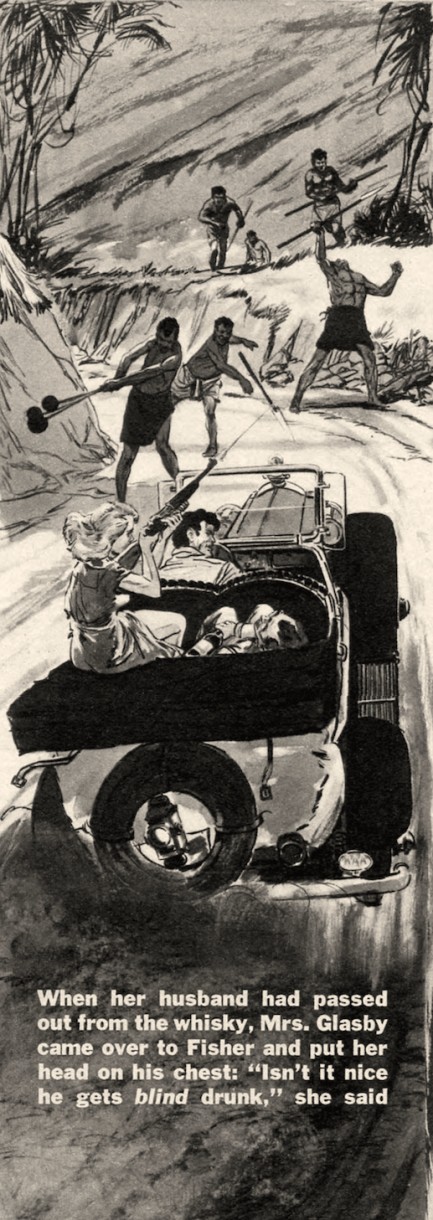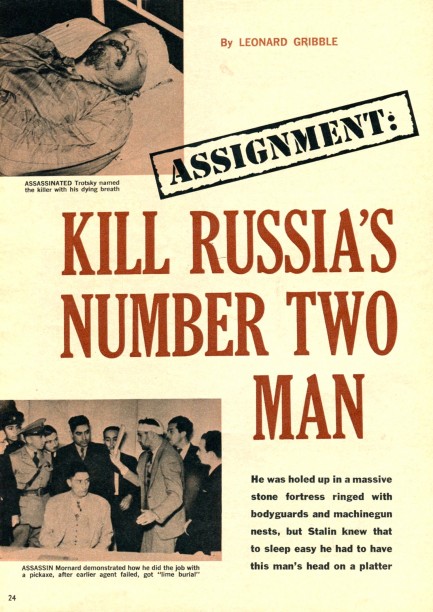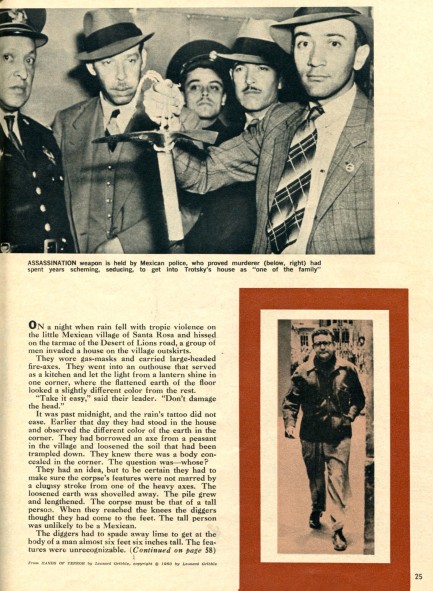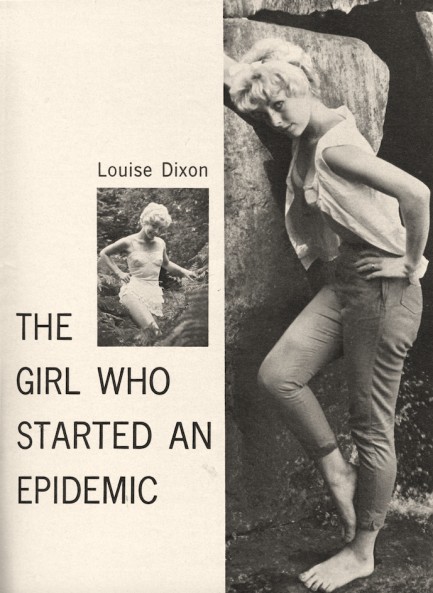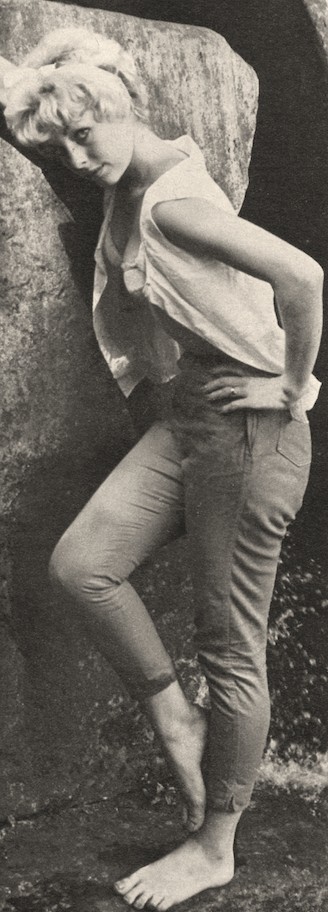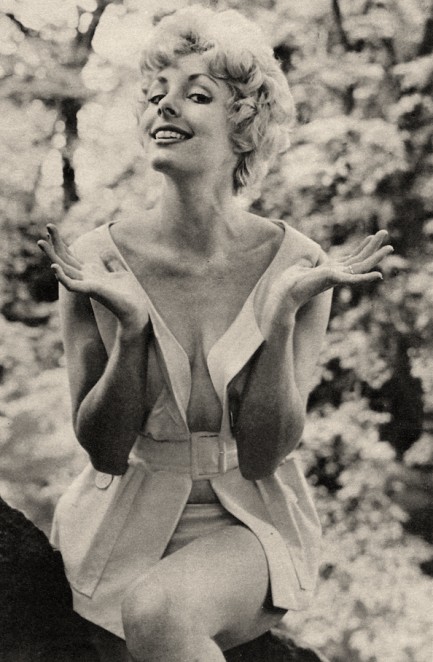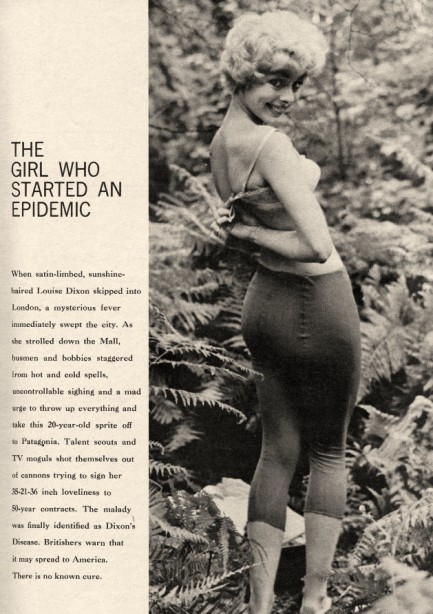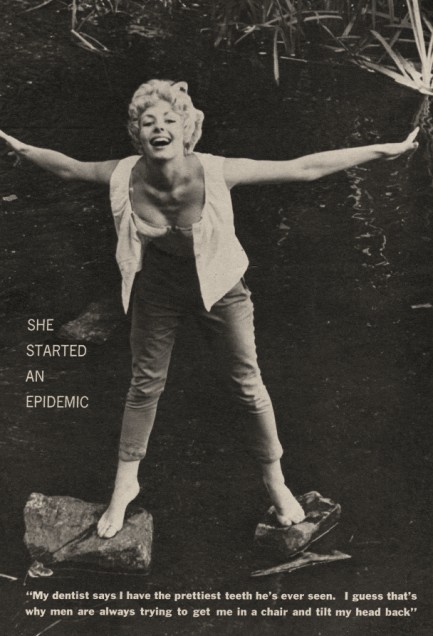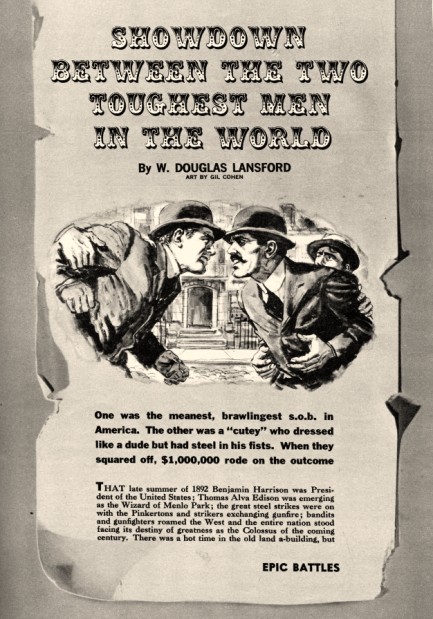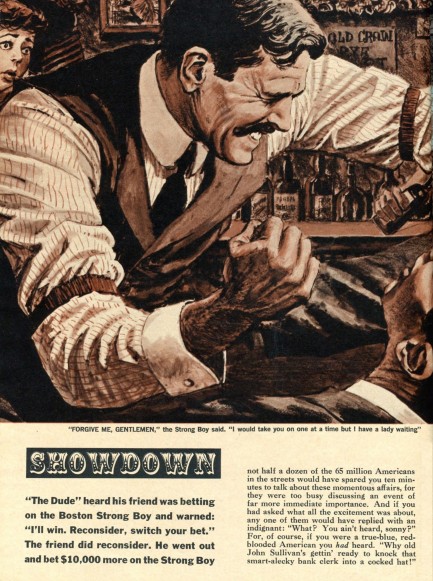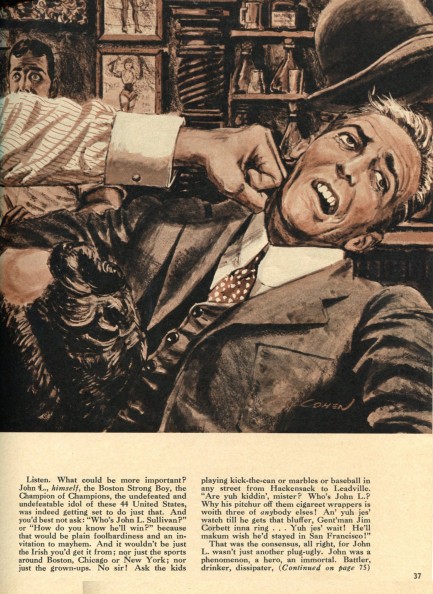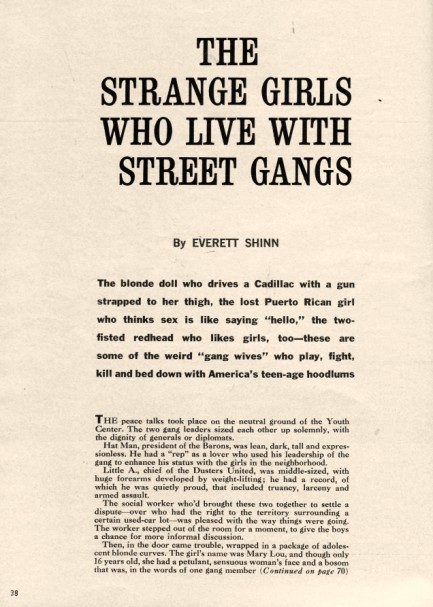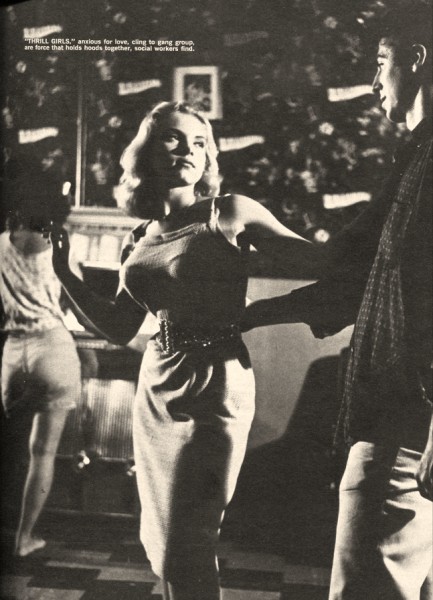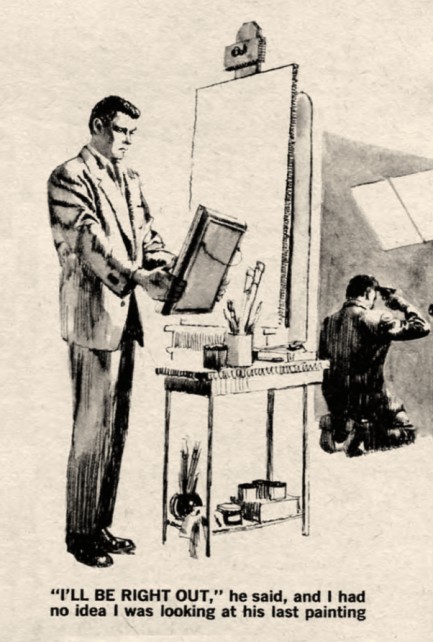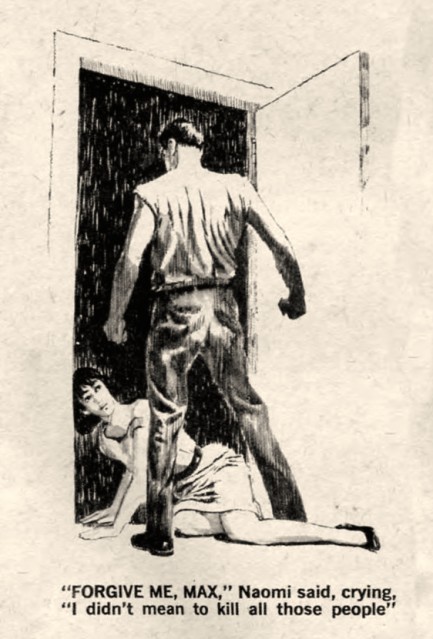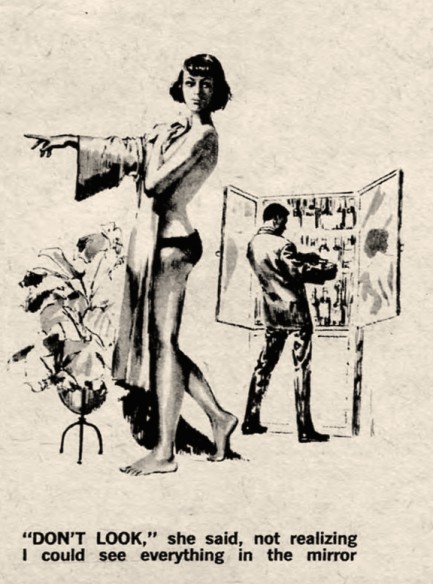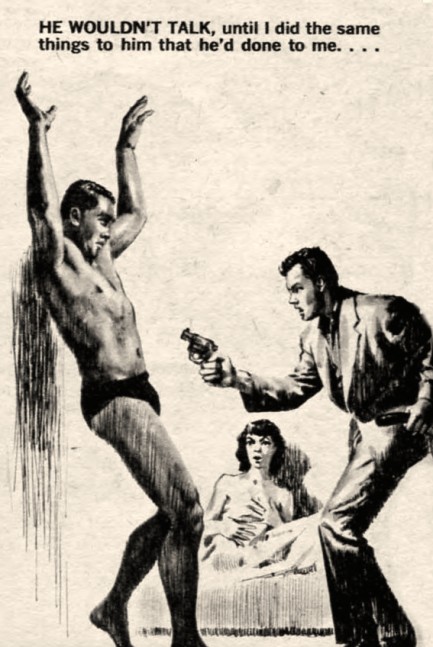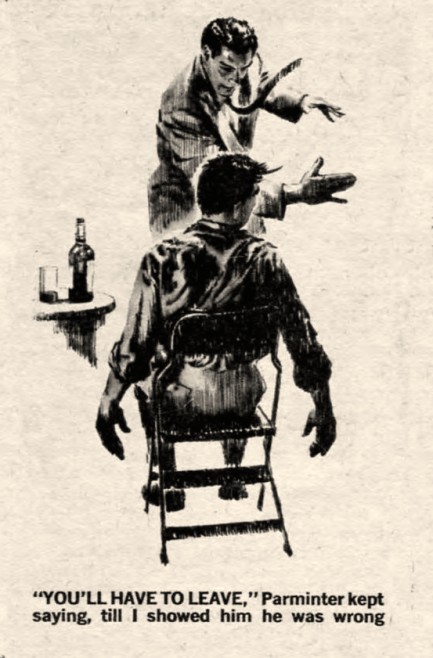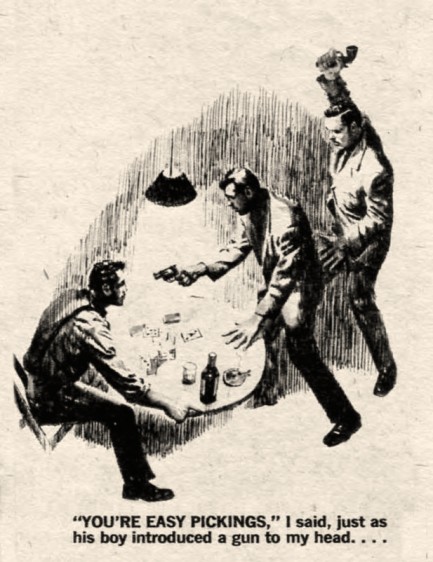 Toto we’re not in Africa anymore. 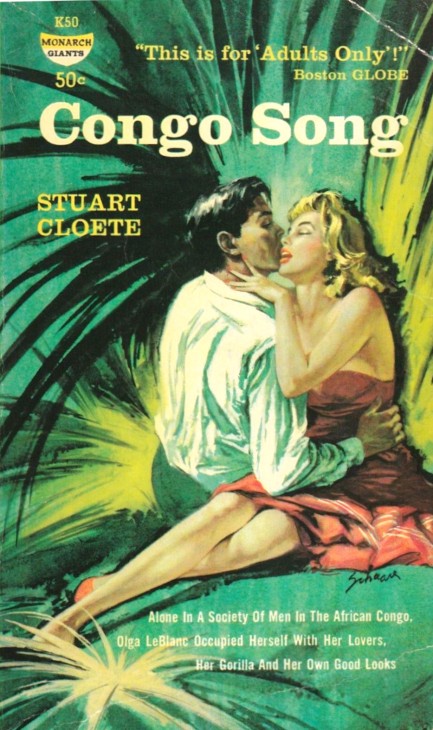
We said we'd get back to Stuart Cloete’s 1943 jungle drama Congo Song, and here we are. The book has been reprinted often, including in the 1958 Monarch edition you see above, with Harry Schaare cover art. Its popularity certainly owed something to the fact that it was another book that nurtured popular Western stereotypes about life in Africa, including that it attracted decadent and damaged whites whose weaknesses were inevitably amplified by the deep, dark, primitive, savage, mysterious continent. You've read something like this once or twice, we bet, thanks to Hemingway and others, though Cloete, who was from South Africa, writes in an entirely different style than Papa:
This was the Congo song: the song of sluggish rivers, of the mountains, the forests; the song of the distant, throbbing drums, of the ripe fruits falling, of the mosquitoes humming in the scented dusk; the song of Entobo, of the gorilla, and the snake. The song no white man would ever sing. The wild dogs cry out in the night as they grow restless, longing for some solitary company. Oops—that last sentence is from the Toto song “Africa.” Don't know how that slipped in there. Anyway, Congo Song unfolds in the months before the start of World War II. Cloete’s characters are diverse, with his main creation being Olga le Blanc, the only woman living in an isolated outpost called Botanical Station with several men, including her husband, a researcher who spends a lot of time away. Olga is a vamp who must make other men fall in with love her, and her affections don't end at homo sapiens sapiens—she has a gorilla, unsubtly named Congo, that she nursed at her own breast when it was an infant. Cloete’s symbolism is pretty thick milk. Erudite conversation, circular philosophizing, seductions, and secrets abound at Botanical Station. One of the other main characters is an American named Henry Wilson who has been sent by handlers in Nairobi to keep an eye on the doings of a German spy named Fritz von Brandt. Olga, meanwhile, spies on von Brandt for the English—sometimes from his bed. Other characters have less purpose, and many eccentricities. One drinks too much. Another sleeps with teenaged Congolese girls under the guise of employing them as domestics. The researcher seems to love trees more than Olga. Nobody is particularly happy. Who is who? Who wants what? There's another spy, who we won't name, a machine-like man, asexual, immune even to Olga: Women were the weakness of so many. Money, luxury, power, all resolved themselves finally into women. That was where the money went. That was what the power was used to obtain. How lucky he was to have been born without sexual feelings. All the duplicity in Congo Song derives from the looming war in Europe, but there's also another driver: “Under all this,” Olga observes, “is the never-ending fight for the riches of Africa.”
Despite all the dinners, safaris, subterfuges, and soliloquies—or maybe because of the soliloquies—the book doesn't gather momentum until about page two-fifty, after a fatal accident. Then things move fast enough to cause whiplash. Death comes by various methods, none of them banal. And of course there's still that gorilla. He lives in the house with the le Blancs, but Olga lets him loose regularly. Surely that'll end with limbs separated from bodies and blood on the louvered doors. And Cloete clearly must—absolutely must—squeeze in a little lethal witch-doctoring. No more plot hints. However, it isn't a spoiler to reveal that since Cloete follows the basic blueprint of other books of this type, at least a character or two eventually flee for modern civilization. But they'll remember Congo with bittersweet nostalgia—primarily during a maudlin denouement drawn out over several chapters. But it's understandable—it's not easy to let go of such beauty and horror. Not easy to let go of Congo Song either. It wasn't perfect, but it was very interesting. It’s gonna take a lot to take me awaaaay from yoooou… There’s nothing that a hundred men or moooore could ever doooo… I bless the rains down in Aaaafricaaa… 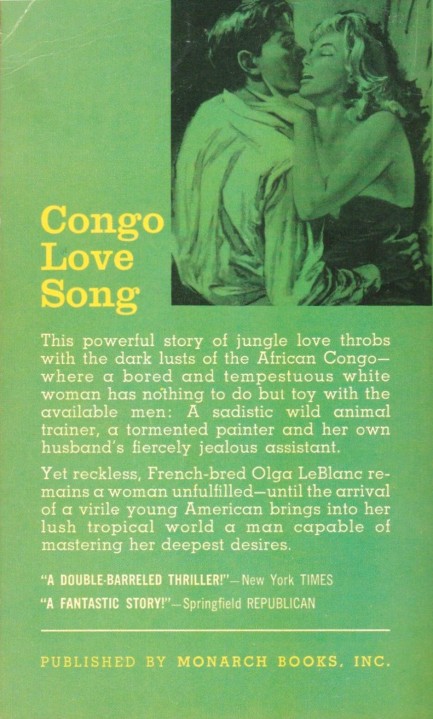
 A femme fatale's deadliest weapon is never a gun. 
We've discussed a few Gil Brewer books without talking much about the man himself. Eventual author of thirty-three novels under his own name and a dozen more under pseudonyms, he started as a literary writer but after selling Satan Is a Woman to Gold Medal Books in 1950 decided that genre fiction was a faster and easier way to earn money. It was also after Satan Is a Woman that drinking began to take a heavy toll on him, to the point of hospitalizations, a near-fatal auto accident, and eventual death. 1961's A Taste for Sin was written during his heavy consumption period, and it's spotty, to say the least, a messily written book, but so crazy it's impossible not to read in a state of wonder.
The story deals with Jim Phalen, a small time crook, an an unlucky one. He meets Felice Anderson, seventeen years old, married at fifteen, recklessly unfaithful from the day she took her vows, and so purely nuts that for sexual thrills she demands to be raped. Explorations of women's alleged rape fantasies were common back then, and at first we thought A Taste for Sin was just another, but Phalen assaults her enthusiastically more than once, making clear that he's had fantasies about this too. Thus, as a shortcut to getting to the essential core of his personality, it's an interesting choice by Brewer. It's clear that Phalen is a throughly bad guy, one who never had much of a chance in life. He won't get much of a chance in this novel either, and doesn't deserve one.
Felice's husband works at a bank and she comes up with a plot to rob it for a million dollars. The only way to succeed is to commit murder. Phalen is horrified at first, but those bedroom games short-circuit his thinking and pretty soon he thinks he sees a way it might work. There are dozens of obstacles, including the police dogging his heels about a robbery he committed early in the story, but it's Felice's wild nature that threatens to become insurmountable. In trying to reflect the confusion in Phalen's mind about her, the pressure he feels from all quarters, and the hasty logistics of the heist, Brewer's narrative becomes like a rock skipping across a pond, hitting and bouncing onward, hitting again, bouncing onward. Phalen even flies to Lucerne, Switzerland, and Brewer expends only a few pages on the entire trip.
We don't feel as if his writing is top notch through any of this, and in our view the narrative is especially loose during its latter third. The story is also rushed during that section—though we do understand that its acceleration may be intended to reflect the lead character's barely maintained control. It just didn't work properly. But we'll give the story credit for its unflinching nature. Did Brewer build it around an underaged femme fatale so nuts as to be unbelievable because he was ambitious, or did she end up on the page due to a booze-fueled lapse in judgment? We'll never know, but Felice, and whether you buy her characterization, is the key to whether you'll like the book. She's a rare creature in the annals of mid-century crime fiction.
 I'm by far the best guide in all of Montana. Unfortunately, I think we've somehow ended up in Manitoba. 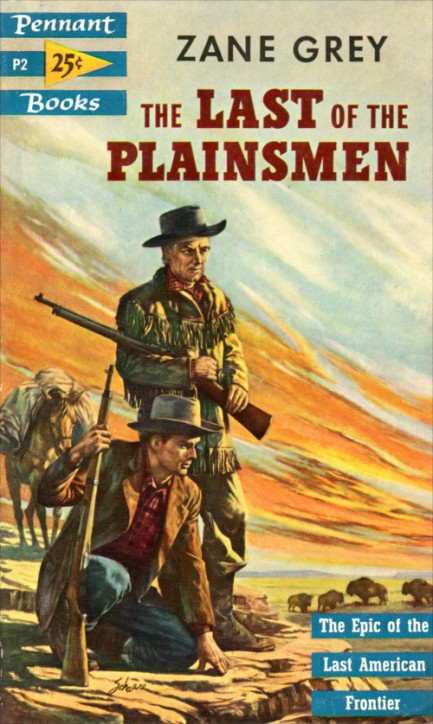
Above: a very nice cover painted by Harry Schaare for Zane Grey's western The Last of the Plainsmen, originally published in 1908, with this Pennant edition coming in 1953. The book tells the story of real life frontiersman Buffalo Jones, aka Charles Jones, and a 1907 journey he made with Grey, so we can assume these two characters in the art are them, one of those rare times an author appeared in his own cover art. The story is actually set in Arizona, not Montana, just in case you took our subhead literally, which you never should. We were going to go with the best guide in Arizona ending up in Sinaloa, but we flipped a buffalo nickel and Canada won.
 I know they cause betrayal and violence, but they're also a girl's best friend, so the least I can do is forgive them. 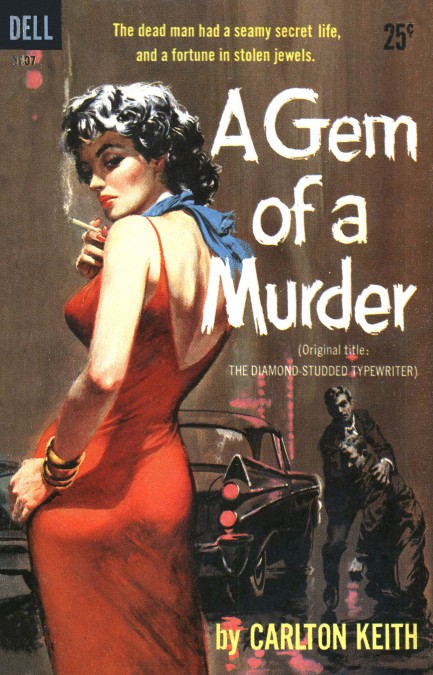
Authors are always looking for new angles for thrillers, which means finding new professions for their protagonists. In Carlton Keith's A Gem of Murder, the main character Jeffrey Green is a document verifier. But he's no dusty old senior with bifocals—no sir. He's an ass kicking, woman chasing, tough-as-nails, he-man. He's asked to confirm whether two writing samples from decades apart are by the same hand, soon learns that a fortune in jewels have gone missing, and encounters many people interested in ascertaining their whereabouts. Despite the document verifier gimmick, the book is a standard mystery, though it tells the reader where the missing jewels are in the first few pages (as does the rear cover). Keith's try at something new could have used more heft, more peril, more propulsion, and probably better writing in general. That's not to say it's bad. It's just that despite its innovative lead character and cleverly hidden jewels it doesn't separate itself from the pack. Originally published in 1958 as The Diamond-Studded Typewriter, this retitled Dell edition with wonderful Harry Schaare cover art came in 1959.
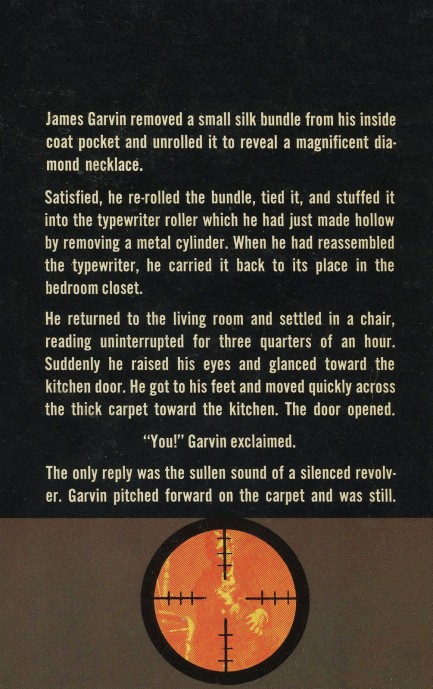
 She knows there's trouble just around the corner. 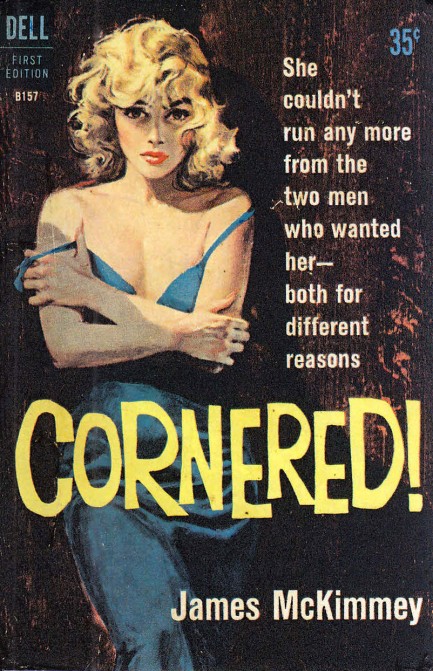
Harry Schaare painted this cover for James McKimmey's 1960 novel Cornered!, which features a woman who's not only cornered but cold, we guess. We last encountered McKimmey back in March when we read his roadgoing thriller The Long Ride, a book we enjoyed. This effort concerns everywoman Ann Rodick, who has fled to a small town to avoid retribution from the big city gangster she put on death row with her trial testimony. She's been hiding for more than a year, but as the date approaches for the gangster's meeting with the hangman, she senses that she's never been in greater danger. She's right about that—the ganster's most fervent wish is to know that Ann has died before he has, and a hitman has been tracking her for months. Now he's close, in the next county, then the next town, and soon, amongst her local acquaintances. But Ann also has two other serious problems: first, in her rush to change her identity she married an awful and abusive man; second, an amazingly sleazy neighbor has uncovered her secret and promises not to tell in exchange for sex. So while the paperback's cover says two men want Ann, actually three men do. Maybe the editors didn't read the book. Oh, and the town doctor is in love with her. So actually, four men want her.
The main character of this scenario can be argued to be the hitman, who has the unlikely name Billy Quirter. He's who the title of the book seems to refer to—McKimmey uses the word “cornered” to explicitly describe the situation in which Quirter finds himself, stuck in a small town with both his prey and the police alerted to his presence. But being cornered doesn't mean he can't get uncornered—all he has to do is fulfill his difficult mission. How he attempts to pull that off, and by what unexpected means he hopes to do so, is the drama that drives the latter half of the book.
Overall, we'd call Cornered! a success. It reminded us of a later author—Stephen King. We know that sounds strange, but McKimmey's broad stroke character development is very Kingian, flaws included. For example, the sleazy neighbor feels that if Ann knew enough to testify against a gangster it's because she must have been a denizen of organized crime herself, which, along with a dash of religious fervor, makes him believe she's evil and he has the right to demand anything he wishes from her. This type of fanaticism drives many King characters, from Margaret White in Carrie to Mrs. Carmody in The Mist to Annie Wilkes in Misery. We'd prefer more subtle motivation, but within the milieu constructed by McKimmey the character works. We've now had two good reads from him, which means we'll try another.
 Put me down, silly. The expression means I want to spend more time outside the cabin. 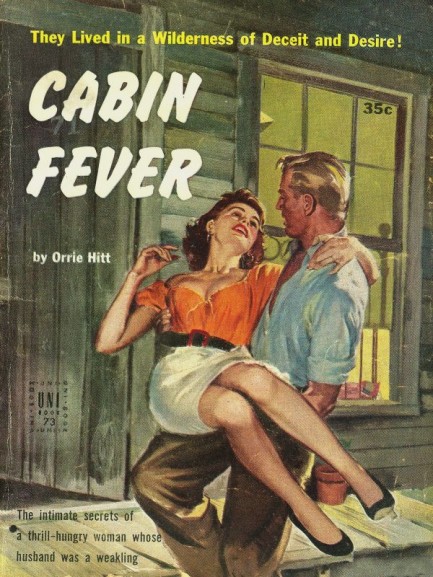
According to medical folklore you're actually supposed to starve a fever, but that doesn't work with this cover at all, so feed it is. Orrie Hitt's Cabin Fever was published in 1954. We've read five of his books, and while we don't want to claim that once you've read that many you've read them all, it sure seems like he hits on the same ideas every time. So we aren't going to acquire this one, but that doesn't mean we won't revisit him later. One thing about Orrie—he's a quick read. Harry Schaare art on this.
 Into battle, me mateys! And tonight for those who survive—extra portions of organic Chai tea! 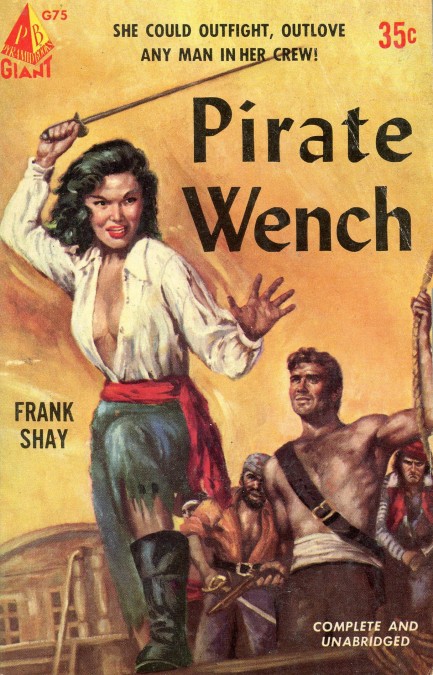
Today is International Talk Like a Pirate Day, not an official holiday, sadly. We asked the Pulp Intl. girlfriends what they'd do if they were pirates and the answers weren't pretty. Making all the men walk the plank was the most charitable of their thoughts, with swords and whips coming into play pretty quickly after that. Good thing we're only supposed to talk like pirates. Arrr... let's tone down the homicidal thoughts, girls.
Above and below is a collection of vintage paperbacks with women pirates. Well, maybe the woman on the cover of Rafael Sabatini's The Fortunes of Captain Blood isn't a pirate so much as someone defending herself. But anyone who can handle two pistols at once is an honorary pirate, at the least. We found eleven examples, and the cover art on display is by Harry Schaare, Rudolph Belarski, Barye Phillips, Paul Anna Soik, and others. 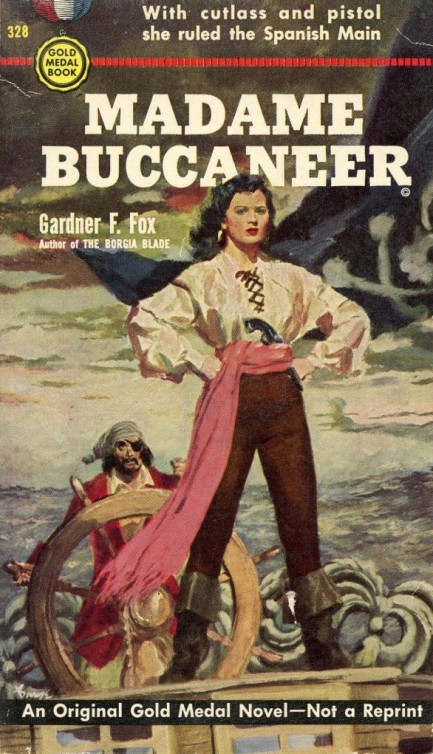 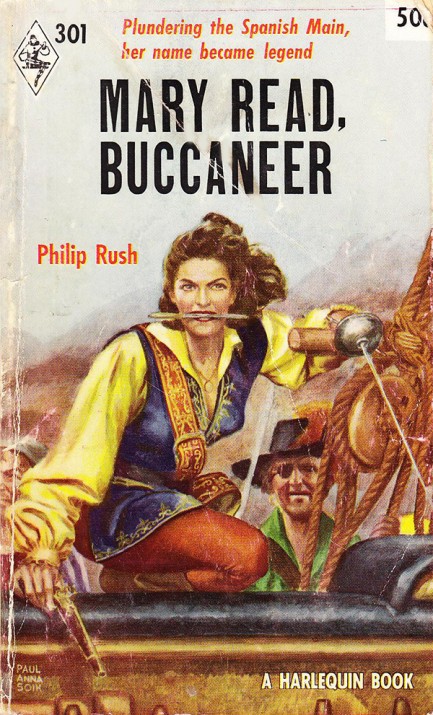 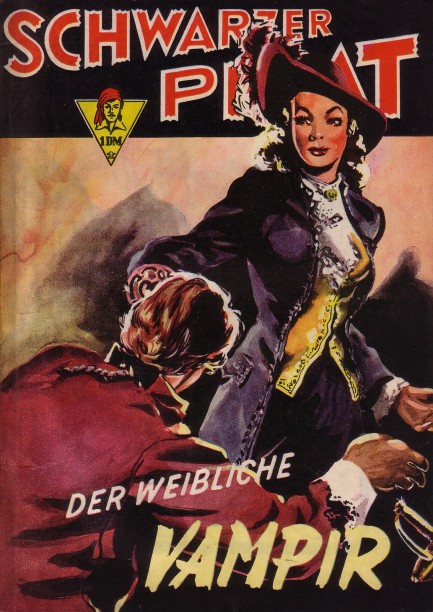 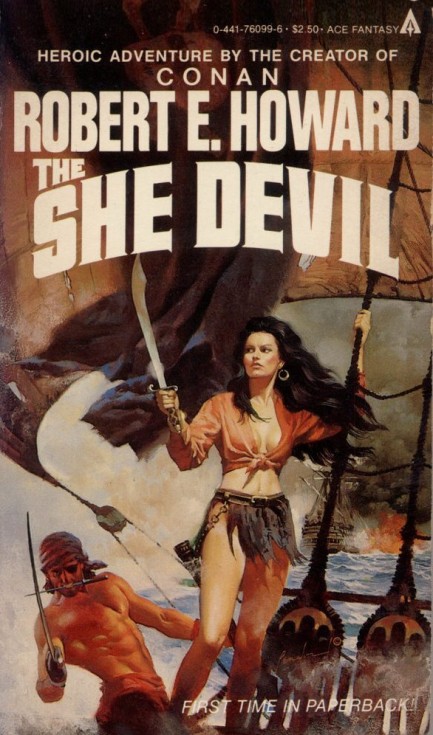 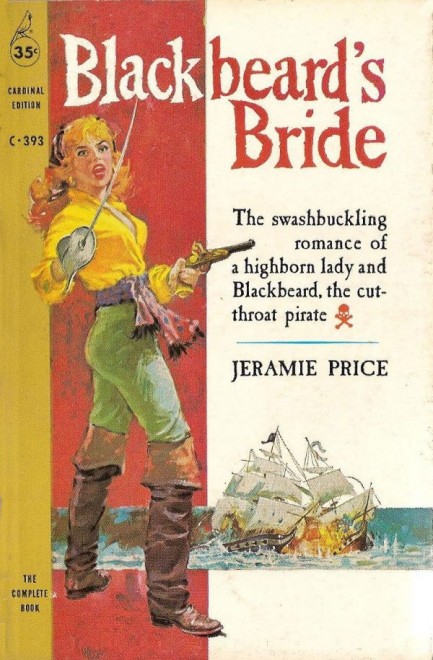 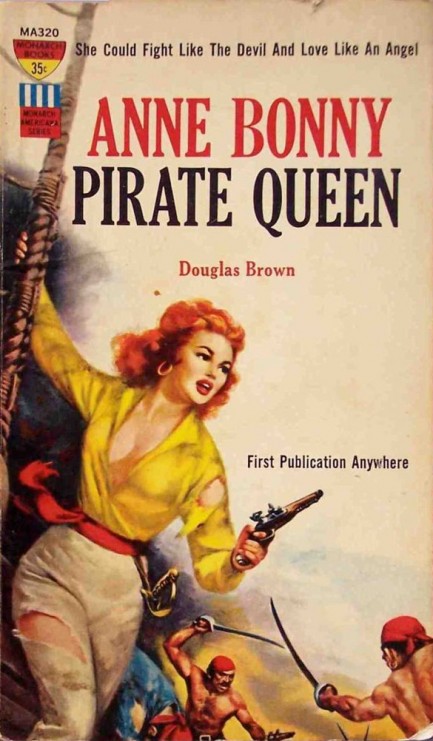 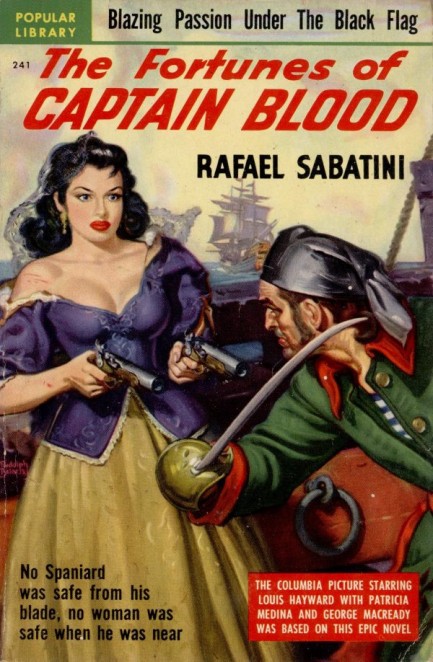 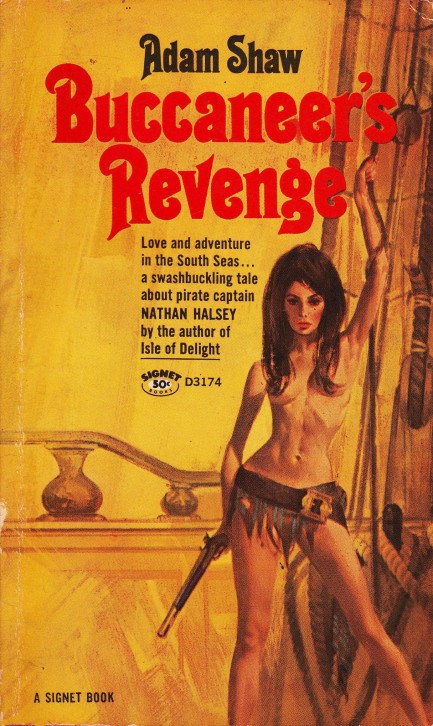 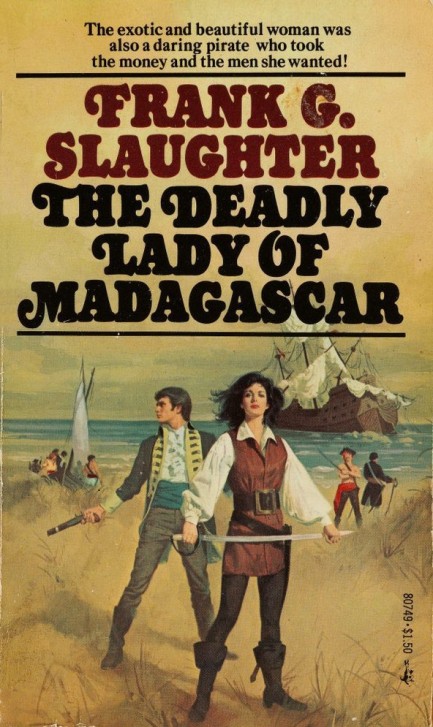 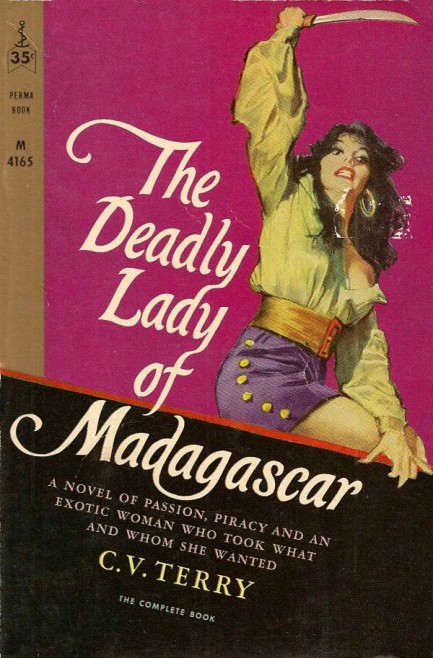 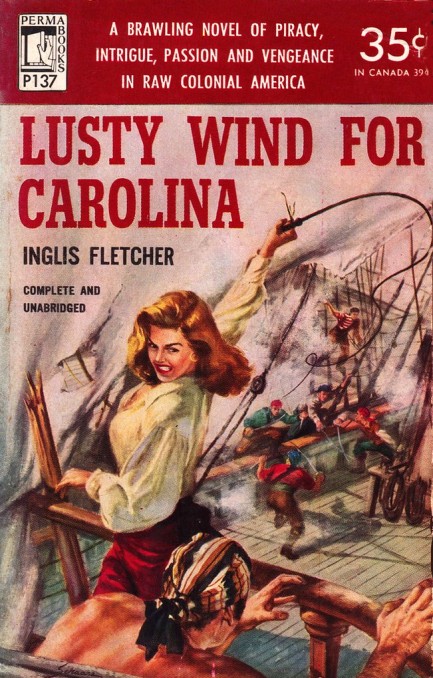
 That's right, I'm looking at you. Read this magazine and learn how to be a real man. 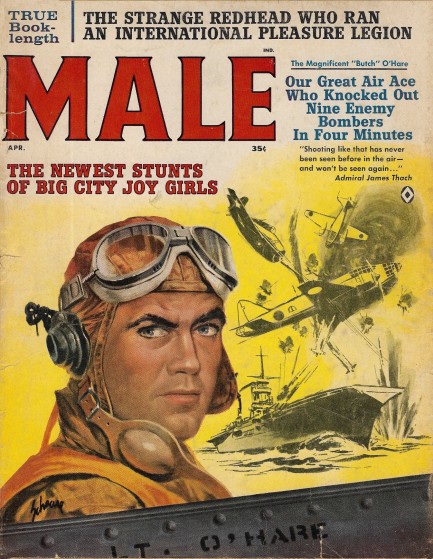
It seems to us that the purpose of men's adventure magazines was to teach ordinary schlubs a little something about how to keep it real, and this issue of Male published in April 1962 fulfills the mandate. Behind the steely-eyed cover art by Harry Schaare, and mixed between interior art by Charles Copeland, Rafael de Soto, James Bama, and Walter Popp, readers learn how to navigate big city vice, survive a nuclear attack, avoid appliance repair scams, pick the perfect car to cruise the open road, and—most importantly—get a raise at their soulsucking office jobs. Those are all fine offerings, but we particularly like the story, “Let's Let the Russians Beat Us to the Moon,” which suggests that if the Russians are so eager to get to the moon let them serve as sacrificial lambs—since the place is filled unknown dangers. Journalist and skeptic Ray Lunt reasons, “For all our scientists know, the moon may be 10,000 miles from where we think it is, paved with quicksand 90 feet deep, and full of brain gas instead of air.” Instead of air? Sounds like he was the one inhaling brain gas. We checked out the story just to find out what brain gas was, and learned basically nothing. He mentions that some scientists—unnamed of course—believe the moon might harbor poisonous gas, but the brain thing never comes up. What a tease. He does, though, run through a long list of other moon horrors fit for a Heinlein novel. He must have been really bummed in 1969 when it turned out to be just a big, dusty rock. We have scans below, and more Male in the website. Feel free to click the keywords. 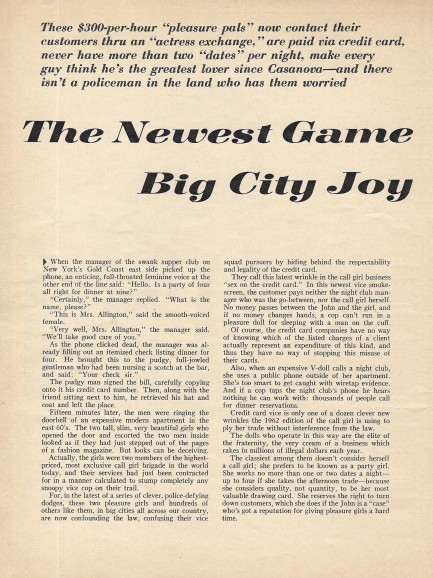 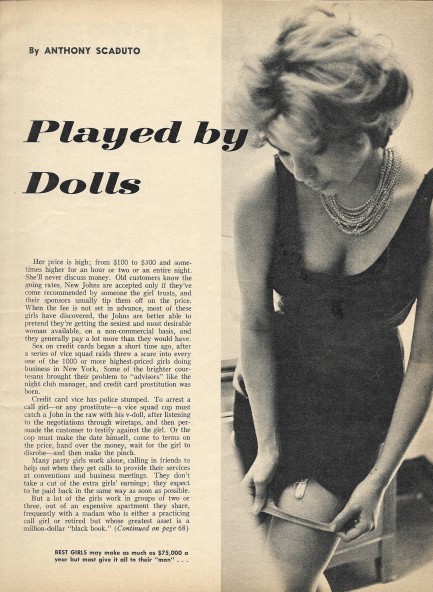 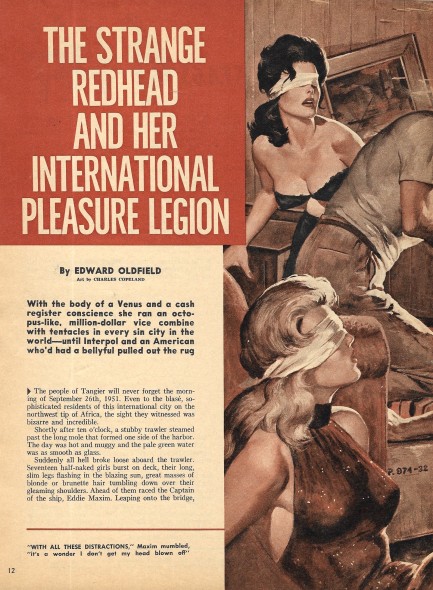 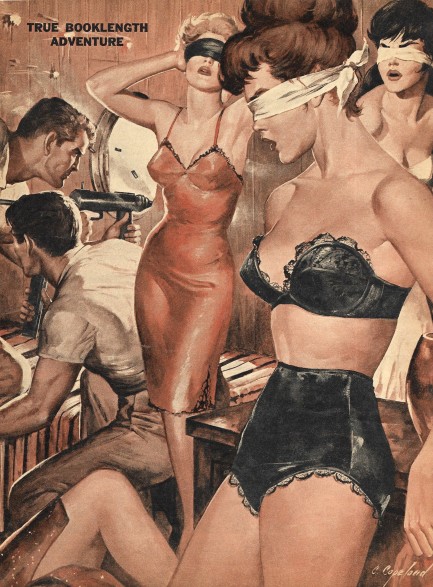 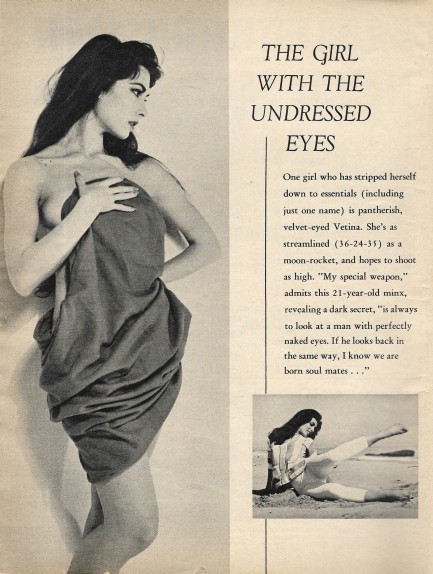 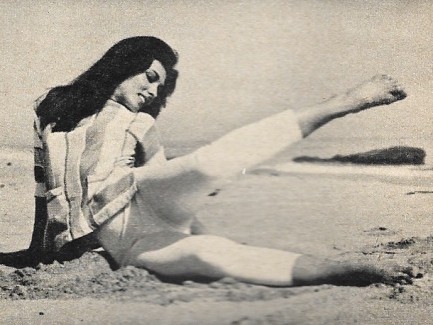  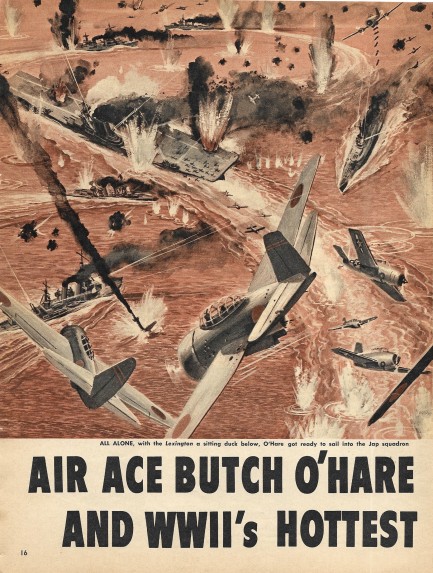 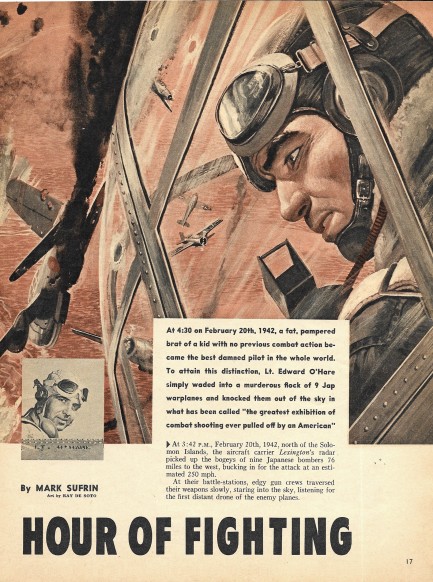 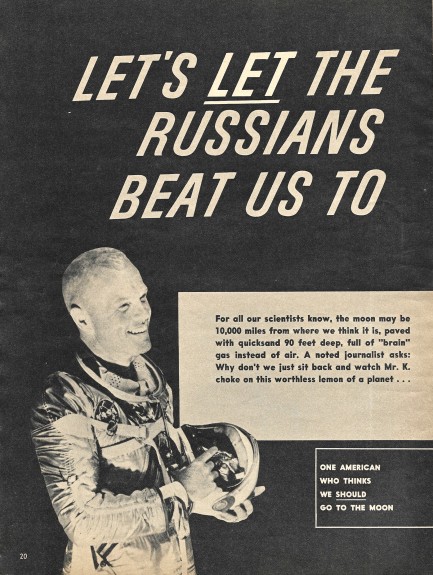 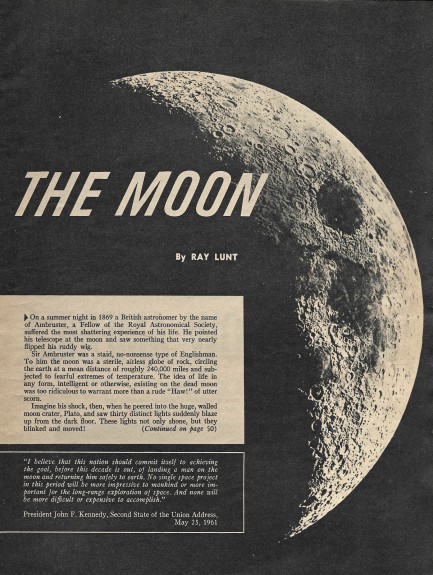 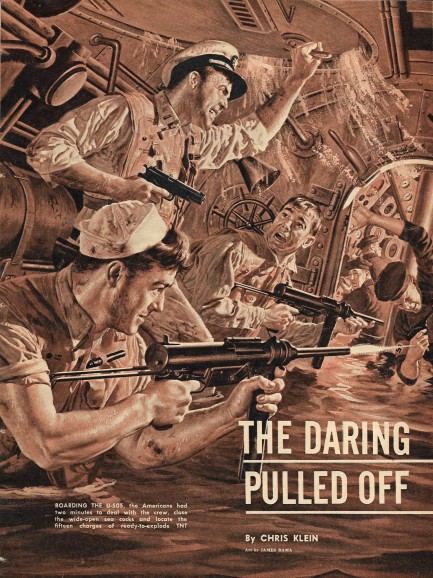 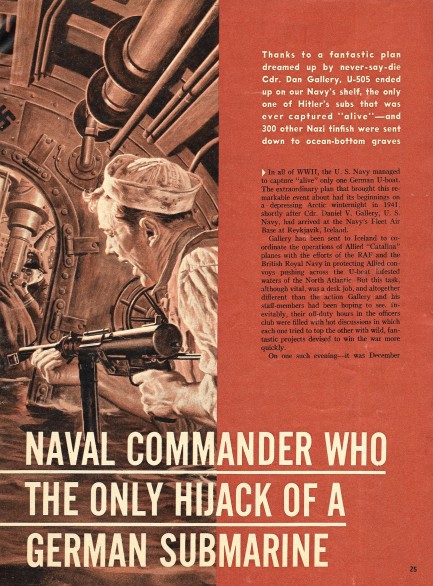 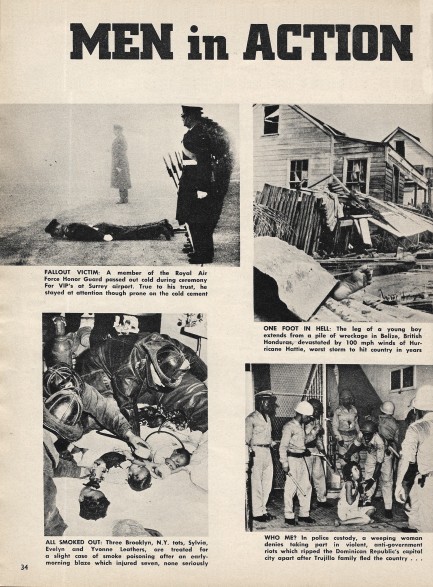 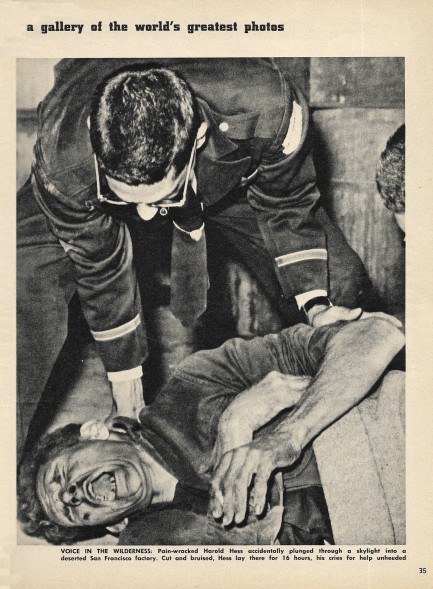 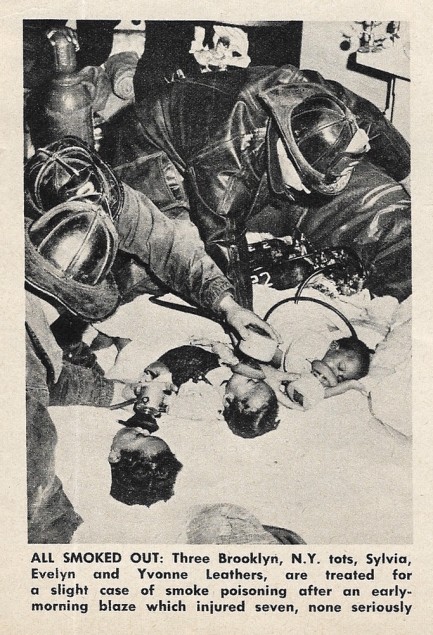 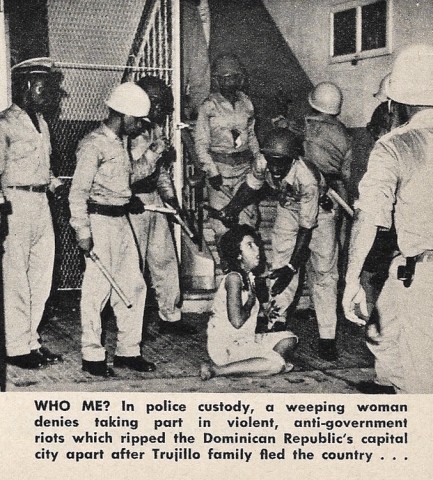  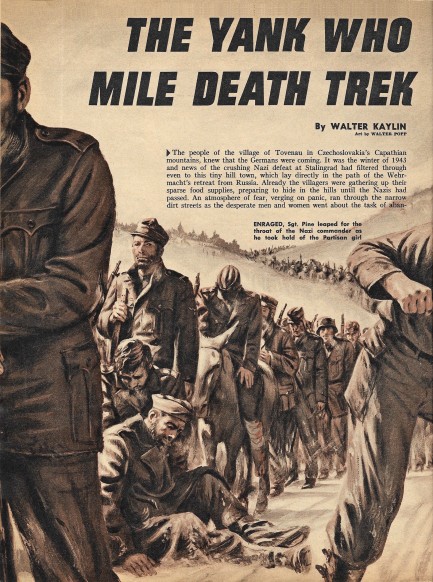 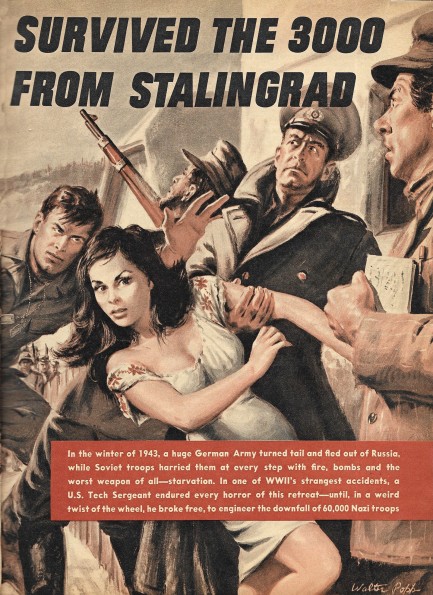 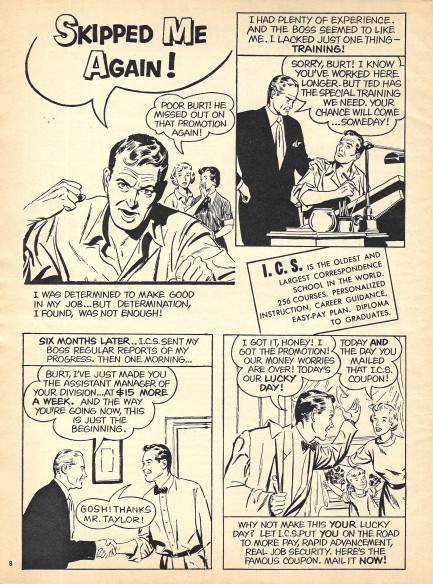 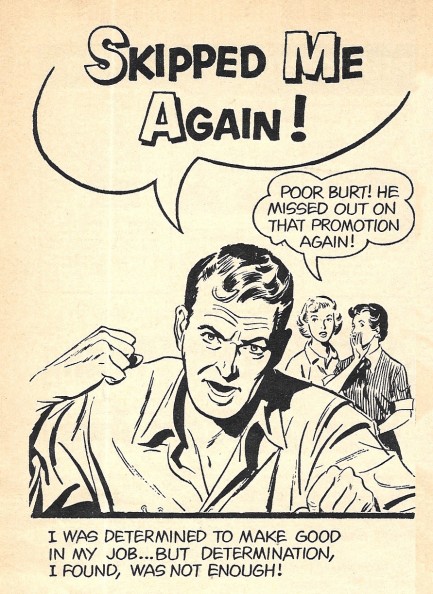 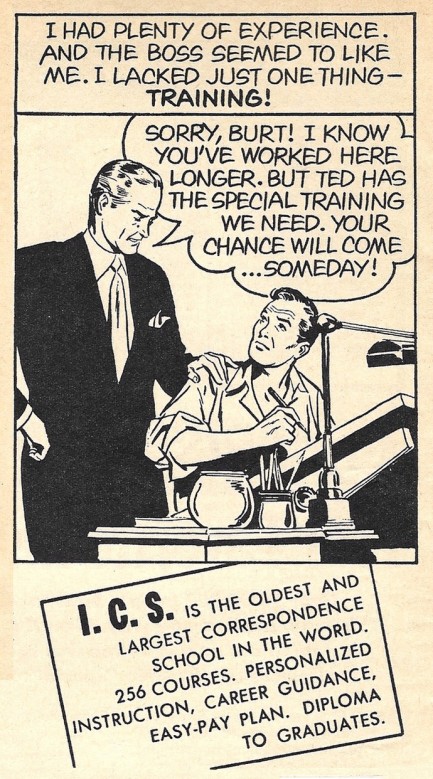 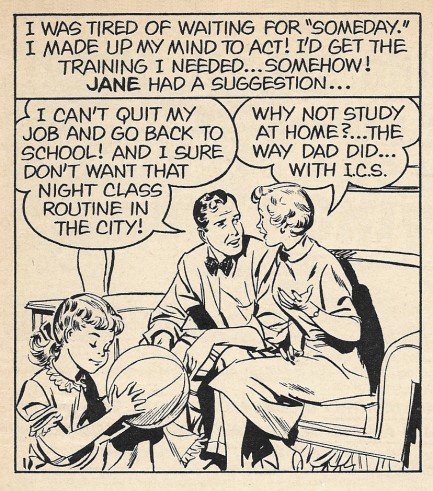 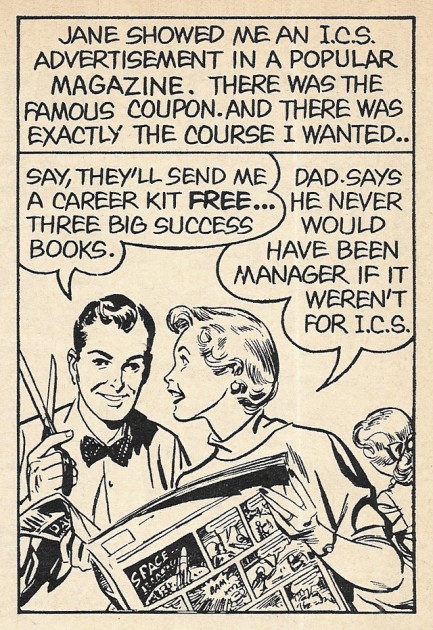 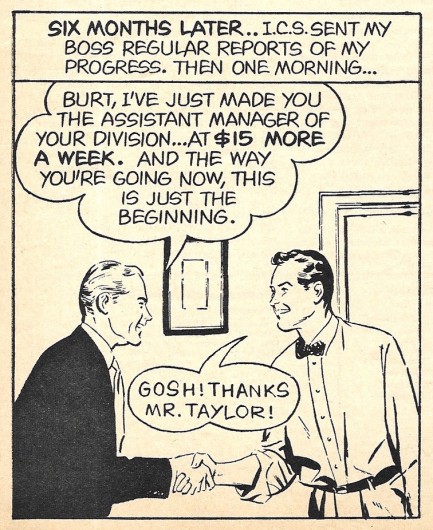 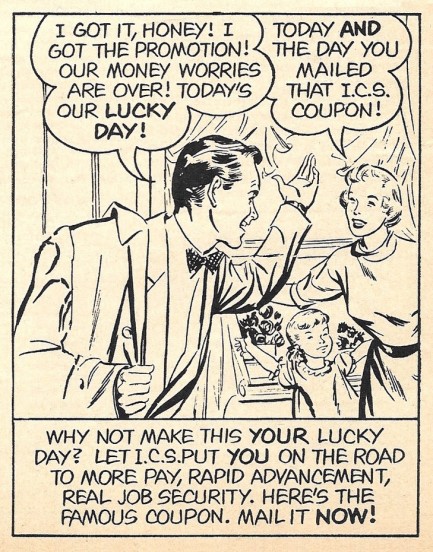
 What the hell are you two snickering about? You never seen a guy polish his tommy gun before? 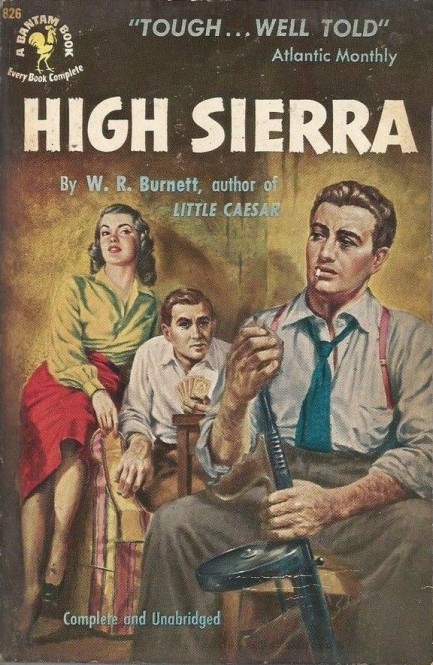
Harry Schaare does nice work on a cover for W.R. Burnett's thriller High Sierra, copyright 1950 from Bantam Books. If anybody snickered it was probably Schaare himself. He had to know how masturbatory this looked, right? Or maybe it's just us. Anyway, this book obviously became a celebrated gangster film noir starring Humphrey Bogart, but the source material is electric. We read it years ago and it stuck with us. Highly recommended.

|
 |

The headlines that mattered yesteryear.
2003—Hope Dies
Film legend Bob Hope dies of pneumonia two months after celebrating his 100th birthday. 1945—Churchill Given the Sack
In spite of admiring Winston Churchill as a great wartime leader, Britons elect
Clement Attlee the nation's new prime minister in a sweeping victory for the Labour Party over the Conservatives. 1952—Evita Peron Dies
Eva Duarte de Peron, aka Evita, wife of the president of the Argentine Republic, dies from cancer at age 33. Evita had brought the working classes into a position of political power never witnessed before, but was hated by the nation's powerful military class. She is lain to rest in Milan, Italy in a secret grave under a nun's name, but is eventually returned to Argentina for reburial beside her husband in 1974. 1943—Mussolini Calls It Quits
Italian dictator Benito Mussolini steps down as head of the armed forces and the government. It soon becomes clear that Il Duce did not relinquish power voluntarily, but was forced to resign after former Fascist colleagues turned against him. He is later installed by Germany as leader of the Italian Social Republic in the north of the country, but is killed by partisans in 1945.
|

|
|

It's easy. We have an uploader that makes it a snap. Use it to submit your art, text, header, and subhead. Your post can be funny, serious, or anything in between, as long as it's vintage pulp. You'll get a byline and experience the fleeting pride of free authorship. We'll edit your post for typos, but the rest is up to you. Click here to give us your best shot.

|
|

























































